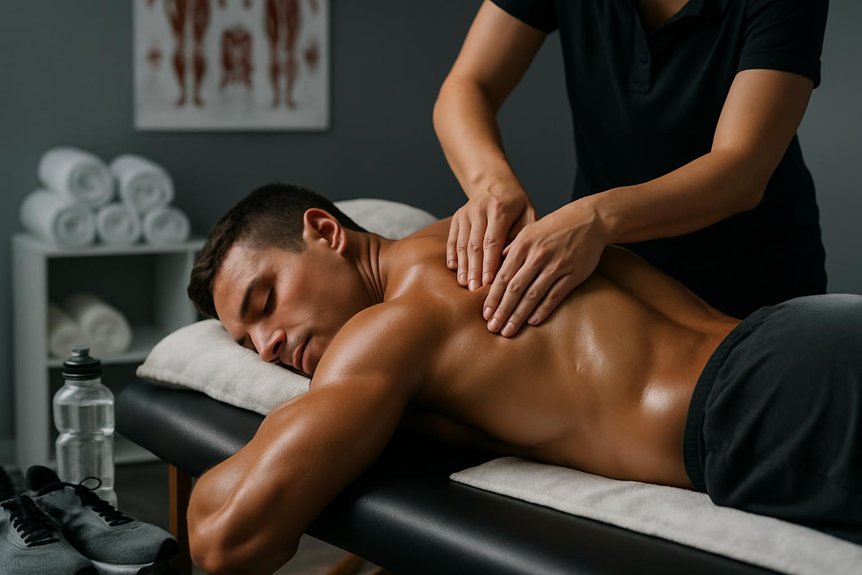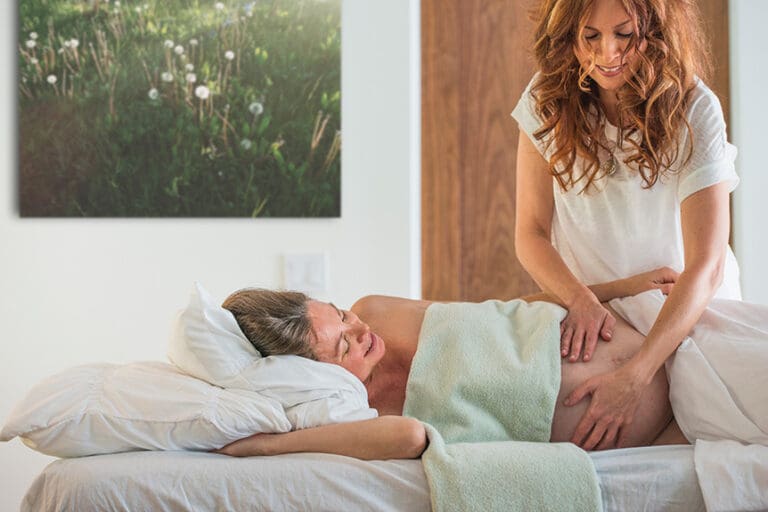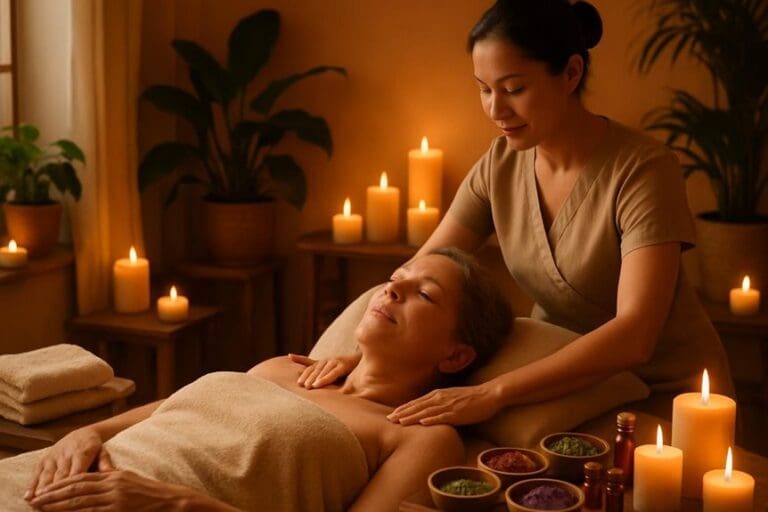Yes. Evidence shows that this massage can modulate pain via mechanoreceptor input, enhance fascial glide, improve microcirculation and lymphatic flow, and increase parasympathetic tone. These effects support flexibility, stretch tolerance, and neuromuscular readiness without impairing performance. Pre-event techniques are light and mobilising; recovery work is slower and deeper to reduce soreness and restore function. Regular, assessment-led sessions aid injury prevention and rehabilitation. Benefits are maximised with appropriate frequency and aftercare. Further details clarify methods, timing, and expected outcomes.
What It Is and Who It’s For
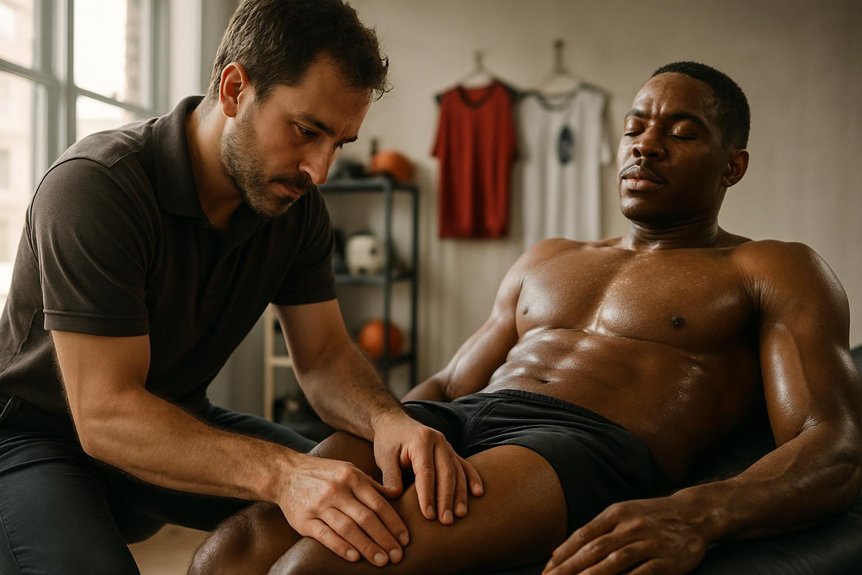
It is a targeted manual therapy that applies specific techniques—such as deep tissue pressure, myofascial release, and assisted stretching—to optimise soft-tissue function, reduce pain, and support performance and recovery.
It focuses on specific muscles, tendons, and fascia implicated in an individual’s activity demands, using structured assessment and treatment planning.
At Spa & Massage clinics in London, therapists deliver sports massage to people who train regularly, return from lay-offs, or manage desk-related stiffness.
It suits runners, lifters, cyclists, racquet players, dancers, and those with repetitive-strain patterns. It also benefits individuals seeking precise relief around the neck, shoulders, hips, or calves.
Sessions are tailored: therapists assess range of motion, palpate tissue quality, and apply graded pressure.
Clients are guided on positioning, breathing, and aftercare—hydration, gentle mobility, and load modulation.
In addition, itsbenefits athletes by supporting both physical recovery and performance, making it a valuable component of athletic care.
The Science Behind Athletic Recovery Massage Benefits
How does targeted manual pressure translate into measurable physiological change? Evidence indicates athletic recovery massage modulates nociception via mechanoreceptor stimulation, reducing pain signaling and perceived soreness.
Shear and compressive forces enhance fascial glide, potentially lowering passive stiffness. Local vasodilation and improved microcirculation support metabolite clearance and nutrient delivery, while gentle lymphatic strokes facilitate interstitial fluid movement, easing swelling.
Downregulation of sympathetic tone and cortisol, paired with increases in parasympathetic activity, fosters relaxation without sedation.
At Spa & Massage, therapists apply graded pressure and myofascial techniques to influence trigger points and neuromuscular tone, then layer in rhythmic effleurage to optimize venous return.
Sessions are structured to respect tissue-load tolerance and recovery timelines, aligning technique selection with presentation—acute tension, delayed-onset soreness, or overuse patterns—so physiology leads, comfort follows.
Performance Gains: Flexibility, Power, and Recovery
While not a substitute for structured training, targeted athletic recovery can measurably influence performance determinants—range of motion, force output, and recovery kinetics. Evidence indicates that myofascial release and longitudinal stripping increase flexibility by reducing passive stiffness and improving stretch tolerance without compromising neuromuscular control.
Brief, firm techniques before activity can enhance power via heightened corticospinal readiness and improved muscle compliance; longer, slower work is reserved for post-session normalization. Recovery benefits arise from enhanced microcirculation, reduced perceived soreness, and quicker restoration of contractile function.
At Spa & Massage clinics across London, therapists sequence treatments to the training calendar: brisk pre-event mobilisations, then post-session flushing and focal trigger-point work. Clients are guided on breath-led downregulation, hydration, and light mobility to consolidate gains between sessions.
Injury Prevention and Rehabilitation Support
Targeted athletic recovery massage can lower cumulative tissue load by improving fascial glide, resolving myofascial trigger points, and normalising muscle tone—key mechanisms in reducing overuse strain.
In our London clinics, therapists apply graded pressure, cross-fibre friction, and assisted stretching to modulate nociception and restore range, which supports faster post‑injury recovery alongside physiotherapy guidance.
Evidence indicates these techniques enhance perfusion and reduce adhesions, helping athletes return to training with fewer setbacks.
Reducing Overuse Strain
A structured athletic recovery massage programme reduces overuse strain by modulating tissue load, improving fascial glide, and restoring neuromuscular balance across repetitive movement chains.
Evidence suggests targeted myofascial techniques reduce nociceptive input, normalise tone in synergists and antagonists, and enhance tendon sliding, lowering cumulative microtrauma.
At Spa & Massage clinics in London, therapists apply calibrated pressure, longitudinal strokes, and cross-fibre friction to address hotspots in commonly overloaded regions—calves, hamstrings, forearms, and rotator cuff.
Session pacing is titrated to training cycles, with shorter, focused treatments before high-volume blocks.
Assessment includes tissue texture, range-of-motion, and provocation tests; interventions are paired with therapist-guided breathing to downregulate sympathetic drive.
Clients receive concise aftercare: light mobility drills, 24-hour load moderation, hydration, and self-massage dosage, maintaining gains and reducing relapse.
Faster Post-Injury Recovery
Because tissue healing follows predictable phases, athletic recovery massage is integrated to support recovery by optimising circulation, modulating pain, and preserving mobility without disrupting repair. Evidence indicates that gentle effleurage and proximal myofascial techniques can reduce oedema via improved lymphatic return, while graded pressure influences nociceptive input and lowers muscle guarding.
Within our Spa & Massage clinics in London, therapists coordinate with clients’ rehabilitation plans, applying stage-appropriate methods: light, non-provocative work in the inflammatory phase; controlled soft-tissue mobilisation and scar management during proliferation; progressive tissue loading and stretching in remodelling.
This approach aims to maintain range, support collagen alignment, and improve tolerance to movement. Therapists provide clear aftercare—heat or cold as indicated, pacing, and home mobility drills—helping clients resume training sooner without compromising tissue integrity.
What to Expect in a Session at Spa & Massage
At Spa & Massage, a athletic recovery massage session begins with a structured pre-session assessment to document symptoms, training load, and range-of-motion findings.
Based on this profile, therapists apply targeted techniques—such as myofascial release, deep tissue stripping, and neuromuscular trigger point work—modulated to tolerance and performance goals.
Aftercare includes specific mobility drills, hydration guidance, heat/cold strategies, and timelines for recovery and follow-up.
Pre-Session Assessment
Initial contact involves a concise pre-session assessment to establish goals, screen for contraindications, and inform treatment planning.
At Spa & Massage, therapists take a focused history: current training load, recent injuries, pain characteristics, red flags (e.g., unexplained swelling, numbness), medications, and relevant medical conditions.
They review previous responses to bodywork and preferred pressure.
Objective screening may include posture observation, active and passive range-of-motion checks, and palpation to identify tone, tenderness, and tissue texture changes.
Consent is explicit and revisited, with clear boundaries about draping and communication.
Clients select target regions and comfort preferences, including pressure tolerance and sensitivity around joints or surgical sites.
Therapists explain likely sensations and immediate effects (e.g., warmth, transient soreness), and agree on session aims: symptom relief, recovery support, or performance preparation aligned with the client’s training cycle.
Tailored Techniques Used
A athletic recovery massage session at Spa & Massage progresses through targeted, evidence‑informed techniques selected to match the client’s goals, tissue presentation, and training phase.
Therapists apply myofascial release to address fascial stiffness, followed by graded deep-tissue stripping along the muscle’s fiber direction to modulate tone without provoking guarding.
Sustained ischemic compressions are used on trigger points, timed with slow breathing to reduce nociceptive drive.
Joint mobilisations and proprioceptive neuromuscular facilitation refine range and restore neuromuscular control.
For pre‑event needs, strokes are lighter and rhythmic to prime tissue; for recovery or chronic overload, slower, deeper work predominates.
Friction techniques target tendon interfaces when indicated.
In our clinics, hypoallergenic oils support glide while preserving tactile precision, and communication remains calm, attentive, and discrete.
Aftercare and Recovery
Following a athletic recovery massage at Spa & Massage, aftercare focuses on controlled recovery to consolidate treatment effects and minimise post‑treatment soreness.
Clinicians advise gentle mobility within pain‑free ranges for 24–48 hours, prioritising hydration to support perfusion and metabolite clearance. Heat or a brief cool compress may be used strategically for comfort.
Therapists at Spa & Massage recommend a protein‑rich meal within hours, light walking, and diaphragmatic breathing to down‑regulate sympathetic tone.
If tenderness arises, it should be mild and transient; sharp or escalating pain warrants reassessment. Stretching is kept low‑load, 20–30 seconds, avoiding aggressive end‑range.
Clients receive personalised guidance on session frequency, load modification, and sleep routines. Many opt for follow‑up deep tissue or mobility‑focused sessions to maintain gains and reduce recurrence.
How Often Should You Book for Optimal Results
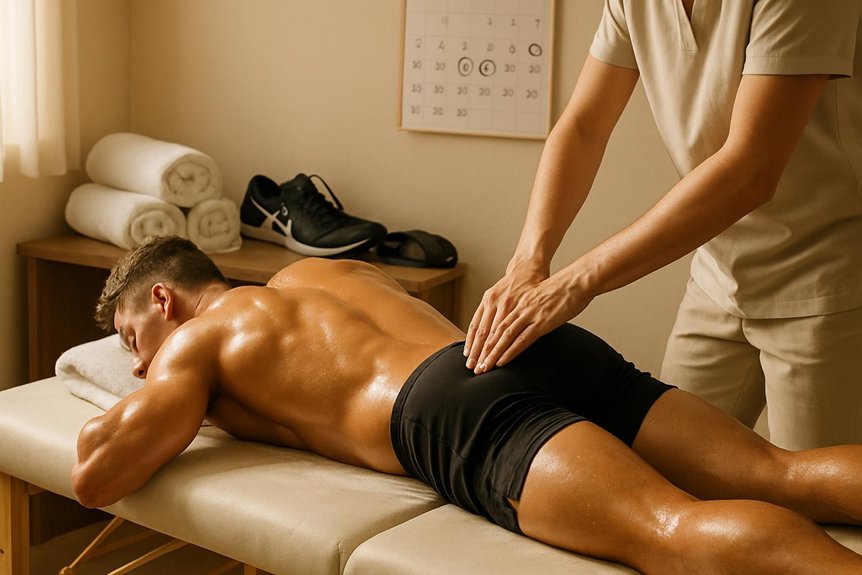
Two variables drive ideal booking frequency for athletic recovery massage: the client’s training load and symptom profile.
For high-volume athletes (5–7 sessions of training weekly), evidence supports weekly or fortnightly sessions to regulate tissue tone, manage DOMS, and maintain range.
Moderate trainers benefit from sessions every 3–4 weeks for upkeep and early intervention.
Acute pain or recent strain warrants an initial block of 3–4 treatments over 2–3 weeks, then tapering.
Chronic tendinopathy or persistent stiffness responds to biweekly care for 6–8 weeks, followed by monthly maintenance.
At Spa & Massage clinics in London, therapists calibrate cadence after evaluating workload, pain irritability, sleep, and recovery markers.
Before races or peak blocks, appointments typically increase; during deload weeks, spacing lengthens.
Precision scheduling protects progress and keeps training intimate, sustainable, and calm.
Aftercare Tips to Maximise the Effects
Booking cadence sets the framework; what happens in the 24–72 hours after a athletic recovery massage determines how well tissues adapt.
Spa & Massage advises gentle circulation work: slow walking, diaphragmatic breathing, and light mobility to maintain perfusion without provoking inflammation.
Hydration targets are simple: sip regularly, prioritising water; limit alcohol for 24 hours.
Within 2–6 hours, apply brief, lukewarm showers; avoid ice unless directed for acute flare-ups.
Clients are encouraged to perform therapist-prescribed stretches, 20–30 seconds, two to three rounds, staying under pain.
Sleep quality is protective; aim for a dark, cool room and consistent bedtime.
For training, keep intensity submaximal for a day; resume heavy work when tenderness resolves.
Our therapists recommend noting DOMS, range changes, and trigger points to refine the next session.
Conclusion
In the end, athletic recovery massage appears to deliver only the modest outcomes the evidence predicts: reduced perceived soreness, short-term flexibility gains, and improved readiness—hardly miraculous, unless one considers sleeping better, moving easier, and training consistently a miracle. At Spa & Massage, tailored techniques align with research and practice, offering incremental benefits that compound with disciplined training, recovery, and load management. Ironically, its real power lies not in heroics but in clinical consistency—precise inputs, predictable outputs, and fewer avoidable setbacks.
